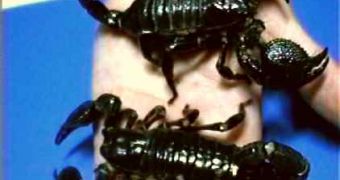Their venomous sting induces terror amongst the inhabitants of the warm zones. But...did you know they are related with spiders and ticks?
1.There are about 1,200 species of scorpions, most of them concentrated in warm areas. The largest is the Emperor scorpion (Pandinus imperator) from the forests of West Africa: up to 18 cm (7 in) long. The smallest scorpions are just 1.3 cm (0.5 in) long.
2.Still, scorpions are found almost on the whole planet, except for Greenland, Antarctica, New Zealand and small oceanic islands. In Europe it can be found north to Germany and a species has been introduced in UK: Euscorpius flavicaudatus. In North America, scorpions reach South Canada. Still, species living in cooler areas are tiny and totally inoffensive for man and scorpions are inactive under 14?C.
2.The scorpion's body is formed by cephalothorax (the fused head and thorax) and the abdomen (the so-called "tail"). The infamous venomous sting is located in the tip of the segmented abdomen.
3.Unlike insects (which have three pairs of feet), scorpions (and spiders) have 4 pairs of walking feet and touch feet (pedipalps or claws). Another issue: scorpions (and spiders), unlike insects, lack any antennae.
4.Scorpions are nocturnal, hiding during the day in cracks, under stones, leaves or abandoned buildings. That's why they can accidentally hide in clothing, footwear, sleeping bags and this is how poisoning occurs.
By night, scorpions go out, searching actively for insect prey.
5.The scorpion venom is of two types. One kind kills or paralyzes just invertebrates, not being more harmful than a wasp bite for man, even if poignant. The second type can paralyze in man the heart and breathing muscles. A dog can die in 7 minutes. Children are especially vulnerable, while an adult can die in a few hours, in the absence of an antidote.
Interestingly, the giant species have venom mostly from the first categories. Most deadly species are medium sized and living in dry areas. All the deadly species belong to the Buthidae family (48 genera and about 500 species), living in Africa and South/Central America. One of the deadliest species is that of the Androctonus genus from North Africa and Middle East, which reaches a length of 10 cm (4 in).
6.Scorpions locate their prey through scent and ground vibrations. The prey is immobilized with the claws and only if necessary, poison is delivered. They ingest only the fluids and soft tissues of their prey.
Being cold blooded, a large prey ensures the food requirement of a scorpion for many days, that's why they do not go out each night. The scorpion's organism is also extremely efficient in keeping water.
7.Scorpions' mating dance can last for hours, the female grabbing the female by the claws with its own claws, starting a go-and-come waltz. Sperm is ejaculated on the ground and the females fix their genitalia to take it. One shot of sperm can be enough to fertilize her several times.
The eggs are carried inside her womb for about a year and offspring are born alive, their number ranging from 1 to 100. The birth can last several days and the majority of the species have two birth sessions, separated by 24 hours.
Till the first melting, when they get a harder exoskeleton, the offspring are carried by the mother on her back.
8.The oldest fossil scorpion is 400 million years old (when the only extant vertebrates were just primitive fish) and looks exactly like modern species. The pattern has resisted for so long precisely due to its success!
9.The scorpions' ancestors were the sea scorpions, that once dominated the oceans. They were huge compared to the scorpions, the largest species being 2.8 meters (9 ft) long, representing the largest Arthropod (invertebrates possessing articulated feet) ever to have lived. The closest living relatives of the sea scorpions are the horseshoe crabs.
10.Scorpions and cockroaches are amongst the only animals known to survive to the detonation of nuclear weapons. They also glow when exposed to UV light (this is how researchers spot them in the night), using UV lamps.

 14 DAY TRIAL //
14 DAY TRIAL //